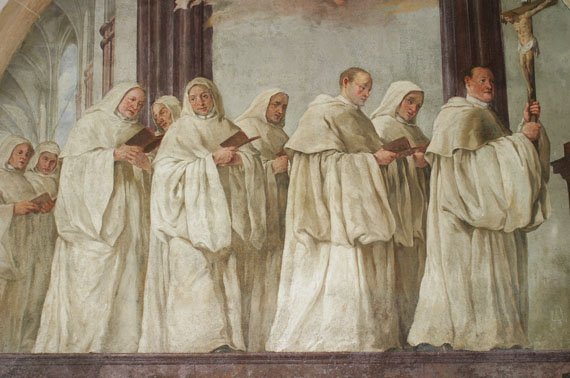
The Cistercian monks (or White Monks) who lived at Tintern followed the Rule of St. Benedict. The Carta Caritatis (Charter of Love) laid out their basic principles, of obedience, poverty, chastity, silence, prayer, and work. With this austere way of life, the Cistercians were one of the most successful orders in the 12th and 13th centuries. The lands of the Abbey were divided into agricultural units or granges, on which local people worked and provided services such as smithies to the Abbey. Many endowments of land on both sides of the Wye were made to the Abbey.
The Cistercians sought out solitude in the mountains and moorlands, and were highly successful. Thirteen Cistercian monasteries, all in remote sites, were founded in Wales between 1131 and 1226. The first of these was Tintern Abbey, which was sited in a remote river valley, and depended largely on its agricultural and pastoral activities for survival. Other abbeys, such as at Neath, Strata Florida, Conwy and Valle Crucis became among the most hallowed names in the history of religion in medieval Wales. Their austere discipline seemed to echo the ideals of the Celtic saints, and the emphasis on pastoral farming fit well into the Welsh stock-rearing economy.
It was as agriculturists and horse and cattle breeders that the Cistercians exercised their chief influence on the progress of civilisation in the Middle Ages. As the great farmers of those days, many of the improvements in the various farming operations were introduced and propagated by them, and this is where the importance of their extension in northern Europe is to be estimated. They developed an organised system for selling their farm produce, cattle and horses, and notably contributed to the commercial progress of the countries of western Europe. To the wool and cloth trade, which was especially fostered by the Cistercians, England was largely indebted for the beginnings of her commercial prosperity.
Wool became so valuable that fortunes were made from growing it, dealing in it and manufacturing it. The highest price English Wool was the 'Lemster Ore', which came from sheep that grazed the lands of the Cistercian houses of Tintern Abbey and Abbey Dore. This was some of the finest wool in Europe.
Farming operations on so extensive a scale could not be carried out by the monks alone, whose choir and religious duties took up a considerable portion of their time; and so from the beginning the system of lay brothers was introduced on a large scale. The duties of the lay brothers, recruited from the peasantry, consisted in carrying out the various fieldworks and plying all sorts of useful trades. They formed a body of men who lived alongside of the choir monks, but separate from them, not taking part in the canonical office, but having their own fixed round of prayer and religious exercises. They were never ordained, and never held any office of superiority. It was by this system of lay brothers that the Cistercians were able to play their distinctive part in the progress of European civilisation.
Until the Industrial Revolution, most of the technological advances in Europe were made in the monasteries. According to the medievalist Jean Gimpel, their high level of industrial technology facilitated the diffusion of new techniques: "Every monastery had a model factory, often as large as the church and only several feet away, and waterpower drove the machinery of the various industries located on its floor." Waterpower was used for crushing wheat, sieving flour, fulling cloth and tanning – a level of technological achievement that could have been observed in practically all of the Cistercian monasteries.
In the reign of King Henry VIII, his Dissolution of the Monasteries ended monastic life in England, Wales and Ireland. On 3 September 1536 Abbot Wyche surrendered Tintern Abbey and all its estates to the King's visitors and ended a way of life that had lasted 400 years. Valuables from the Abbey were sent to the royal Treasury and Abbot Wyche was pensioned off. The building was granted to the then lord of Chepstow, Henry Somerset, 2nd Earl of Worcester. Lead from the roof was sold and the decay of the buildings began.
Supporting the destitute was a problem exacerbated by King Henry VIII's Dissolution of the Monasteries, which began in 1536. They had been a significant source of charitable relief, and provided a good deal of direct and indirect employment. The Poor Relief Act of 1576 went on to establish the principle that if the able-bodied poor needed support, they had to work for it.
The Act for the Relief of the Poor of 1601 made parishes legally responsible for the care of those within their boundaries who, through age or infirmity, were unable to work. The Act essentially classified the poor into one of three groups. It proposed that the able-bodied be offered work in a house of correction (the precursor of the workhouse), where the "persistent idler" was to be punished. It also proposed the construction of housing for the impotent poor, the old and the infirm, although most assistance was granted through a form of poor relief known as outdoor relief – money, food, or other necessities given to those living in their own homes, funded by a local tax on the property of the wealthiest in the parish.
The first authoritative figure for numbers of workhouses comes in the next century from The Abstract of Returns made by the Overseers of the Poor, which was drawn up following a government survey in 1776. It put the number of parish workhouses in England and Wales at more than 1800 (approximately one parish in seven), with a total capacity of more than 90,000 places.